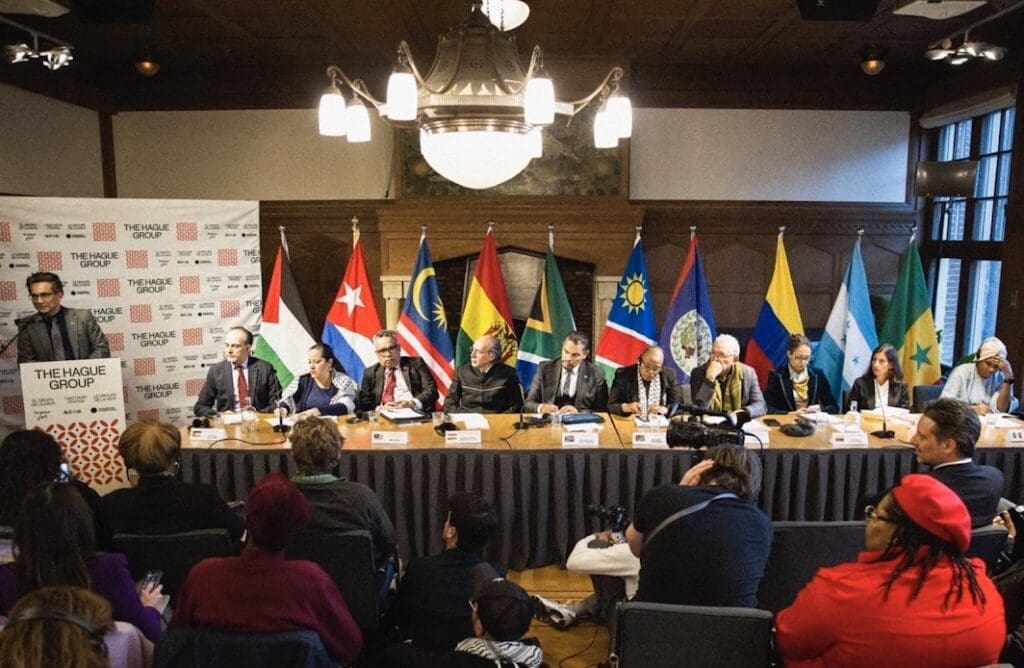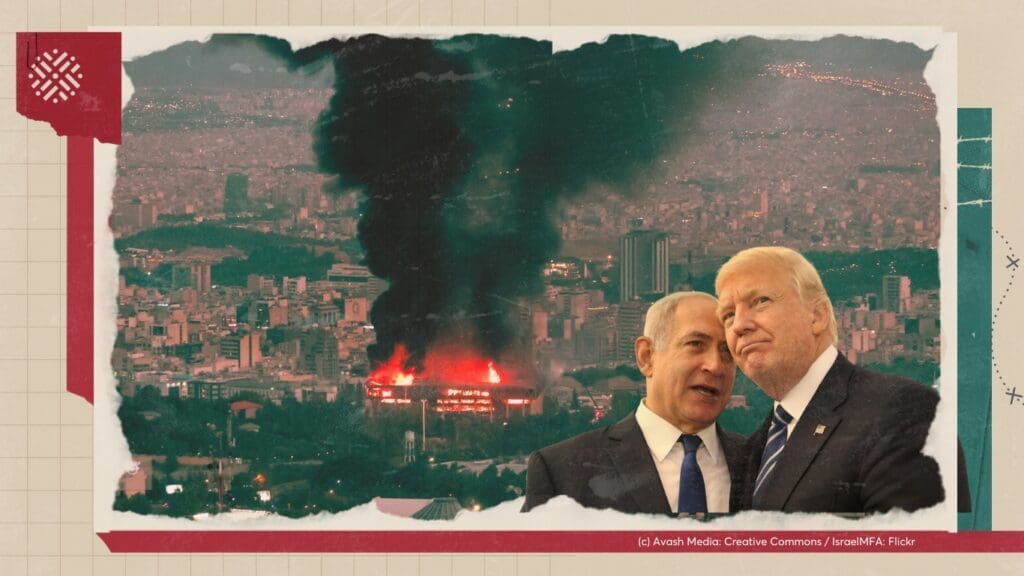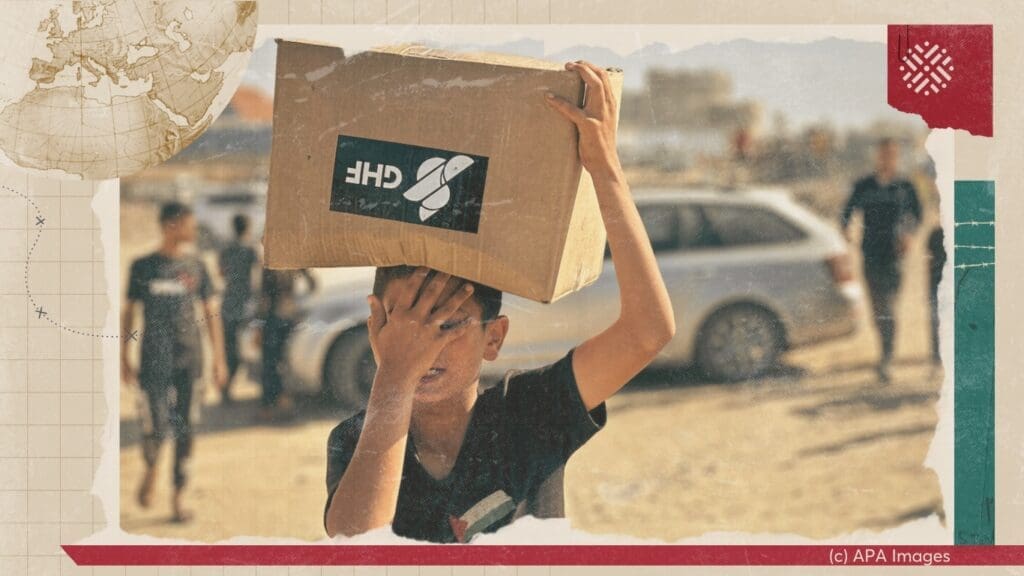- Topics
-
Topics
See our analysis on civil society and how it shapes culture, politics, and policies
Read our insights on the shifting political landscape and what it means for Palestine
Learn more about the policies and practices shaping the Palestinian economy
Strengthen your understanding of the unique conditions for Palestinian refugees across the Middle East
-
- Analysis
-
Analysis
In-depth analysis on existing or potential policies that impact possibilities for Palestinian liberation.
Insights and perspectives on social, political, and economic questions related to Palestine and Palestinians globally.
Concise analysis into a specific policy, its background and implications.
Commentary that brings together insights from multiple analysts.
Compilations of past Al-Shabaka works surrounding a specific theme.
Longer-form, ad hoc projects that seek to confront research questions outside the scope of our regular analysis.
A policy-driven research initiative by Al-Shabaka: The Palestinian Policy Network.
Our monthly webinar series that brings together Palestinian experts.
Featured
The Israeli regime’s ongoing genocide in Gaza has exposed the failure of international legal frameworks to protect civilians, marking an unprecedented breakdown in the protective function of international law. While the Genocide Convention obligates states to prevent and punish genocide, and the Geneva Conventions establish protections for civilians under occupation, these mechanisms have proven powerless without the political will to enforce them. In this context, eight Global South states—South Africa, Malaysia, Namibia, Colombia, Bolivia, Senegal, Honduras, and Cuba—have launched the Hague Group, a coordinated legal and diplomatic initiative aimed at enforcing international law and holding the Israeli regime accountable. This policy memo examines the group’s efforts to challenge entrenched Israeli impunity. It highlights the potential of coordinated state action to hold states accountable for violating international law, despite structural limitations in enforcement. Munir Nuseibah· Jul 8, 2025On Thursday, June 19, 2025, Israeli Prime Minister Benjamin Netanyahu stood in front of the aftermath of an Iranian strike near Bir al-Saba’ and told journalists: “It really reminds me of the British people during the Blitz. We are going through a Blitz.” The Blitz refers to the sustained bombing campaign carried out by Nazi Germany against the UK, particularly London, between September 1940 and May 1941. With this dramatic comparison, Netanyahu sought to elicit Western sympathy and secure unconditional support for his government’s latest act of military escalation and violation of international law: the unprovoked bombing of Iran. This rhetorical move is far from new; it has become an enduring trope in Israeli political discourse—one that casts Israel as the perennial victim and frames its opponents as modern-day Nazis. Netanyahu has long harbored ambitions of striking Iran with direct US support, but timing has always been central. This moment, then, should not be viewed merely as opportunistic aggression, but as part of a broader, calculated strategy. His actions are shaped by a convergence of unprecedented impunity, shifting regional dynamics, and deepening domestic political fragility. This commentary examines the latest escalation in that context and discusses the broader political forces driving it.
Munir Nuseibah· Jul 8, 2025On Thursday, June 19, 2025, Israeli Prime Minister Benjamin Netanyahu stood in front of the aftermath of an Iranian strike near Bir al-Saba’ and told journalists: “It really reminds me of the British people during the Blitz. We are going through a Blitz.” The Blitz refers to the sustained bombing campaign carried out by Nazi Germany against the UK, particularly London, between September 1940 and May 1941. With this dramatic comparison, Netanyahu sought to elicit Western sympathy and secure unconditional support for his government’s latest act of military escalation and violation of international law: the unprovoked bombing of Iran. This rhetorical move is far from new; it has become an enduring trope in Israeli political discourse—one that casts Israel as the perennial victim and frames its opponents as modern-day Nazis. Netanyahu has long harbored ambitions of striking Iran with direct US support, but timing has always been central. This moment, then, should not be viewed merely as opportunistic aggression, but as part of a broader, calculated strategy. His actions are shaped by a convergence of unprecedented impunity, shifting regional dynamics, and deepening domestic political fragility. This commentary examines the latest escalation in that context and discusses the broader political forces driving it. Yara Hawari· Jun 26, 2025Launched on May 26, 2025, and secured by US private contractors, the new Israeli-backed aid distribution system in Gaza has resulted in over 100 Palestinian deaths, as civilians navigated dangerous conditions at hubs positioned near military outposts along the Rafah border. These fatalities raise grave concerns about the safety of the aid model and the role of US contractors operating under Israeli oversight. This policy memo argues that the privatization of aid and security in Gaza violates humanitarian norms by turning aid into a tool of control, ethnic cleansing, and colonization. It threatens Palestinian life by conditioning life-saving aid, facilitating forced displacement, and shielding the Israeli regime from legal and moral responsibility. It additionally erodes local and international institutions, especially UNRWA, which has been working in Gaza for decades.
Yara Hawari· Jun 26, 2025Launched on May 26, 2025, and secured by US private contractors, the new Israeli-backed aid distribution system in Gaza has resulted in over 100 Palestinian deaths, as civilians navigated dangerous conditions at hubs positioned near military outposts along the Rafah border. These fatalities raise grave concerns about the safety of the aid model and the role of US contractors operating under Israeli oversight. This policy memo argues that the privatization of aid and security in Gaza violates humanitarian norms by turning aid into a tool of control, ethnic cleansing, and colonization. It threatens Palestinian life by conditioning life-saving aid, facilitating forced displacement, and shielding the Israeli regime from legal and moral responsibility. It additionally erodes local and international institutions, especially UNRWA, which has been working in Gaza for decades. Safa Joudeh· Jun 10, 2025
Safa Joudeh· Jun 10, 2025
-
- Resources
- Media & Outreach
- The Network




Gaza: The Enduring Siege
Overview
Much attention has been paid to Israel’s “easing” of its siege of Gaza in early July 2010. Palestinians in Gaza now have access to previously banned items like pasta and chocolate. However, there is no freedom of movement for people and goods. In other words, Gaza remains under siege as it has since 2006, almost completely isolated from the rest of the world. Al-Shabaka Policy Advisor Haidar Eid reflects on the extent to which the apartheid analogy applies to the situation in Gaza. He draws telling comparisons with the struggle against apartheid in South Africa and argues that the Palestinian national movement has ignored those lessons to its own detriment.
Israeli-Apartheid in Gaza?
The Palestinian national movement has overlooked this question: Does the Gaza Strip resemble the racist Bantustans of apartheid South Africa? During the apartheid-era, South Africa’s black population was kept in isolation and without political and civil rights. Is Gaza similar? The answer is yes and no.
What is apartheid? As defined by the 1973 United Nations convention, apartheid is a policy of racial or ethnic segregation founded on a set of discriminatory practices that favor a specific group in order to ensure its racial supremacy over another group.1 In Israel, institutionalized racial discrimination is unequivocally founded on ensuring the primacy of a group of Jewish settlers over the Palestinian Arabs. When comparing the applications of the apartheid policy, it is difficult to identify any differences between white rule in South Africa and its Israeli counterpart in Palestine in terms of the segregation and designation of certain areas to Israeli Jews and others to the Arabs, the delineation of certain laws and privileges for Jews and a discriminatory set of laws that apply only to Palestinians.
Currently, in both Israel and the Occupied Palestinian Territories (OPT) there are two road systems, two housing systems, two educational systems, and different legal and administrative systems for Jews and non-Jews. Every law enacted during the South African apartheid system has a corresponding law in Israel. This includes the Group areas act, the Prohibition of Mixed Marriages Act, the Law on Movement and Permits, the Public Safety Act, the Population Registration Act, the Immorality Act, the Land Act and, of course, the Bantu Homelands Citizenship Act. The corresponding Israeli laws are the Law of Return, the 2003 “temporary” laws prohibiting mixed marriages, the Population Registry Law, the Citizenship and Entry into Israel Law, the Israeli Nationality Law, and land and property laws.
Like South Africa, Israel’s brand of apartheid is mixed with settler colonialism. As in the United States and Australia, settler colonialism in Israel and South Africa has also involved the ethnic cleansing or genocide of the indigenous people influenced by a racist and/or religious ideology of supremacy.
When evaluated along these lines, the term apartheid clearly applies to Israeli policies in the Gaza Strip. The Palestinians of the Gaza Strip are isolated from the rest of the population in historical Palestine, and do not enjoy minimum political rights and basic living conditions available to Jewish residents because they were born to mothers from the “wrong” religion. In this context, it should be recalled that 80% of the population in the Strip were ethnically cleansed in 1948 and are barred from returning to the villages and cities from which they were driven.
The Bantustans were part of the apartheid regime’s racist formula to separate the black population and preserve “white supremacy.” Although the Bantustans were called “independent homelands,” their inhabitants were not granted equal rights or even independent political decision-making power — a harbinger of what is planned for the so-called independent Palestinian state within the June 1967 borders. In South Africa, the debate was about 11 states that could live side by side in peace. In spite of Pretoria’s best efforts, the Bantustans gained no international recognition save from Israel.
Gaza is deprived of even this racist formula. Israel appears to have learned a lesson from South Africa. It did not appoint local leaders to provide “limited self-government” over the West Bank and Gaza. Rather, in coordination with the United States and shielded by the international community, Israel allowed “free” elections to take place so that the Bantustanization process could gain “legitimacy” and international approval with the consent of the indigenous people. Although hailed internationally, the elections which took place under occupation were a Palestinian tragedy. Israel succeeded in enticing the indigenous people in Palestine to promote the illusion of potential “independence” for segments of 22% of historical Palestine. These parcels of land without sovereignty would be sold to the world as an independent Palestinian state.
Gaza Under Siege
At the same time, the answer to the question of whether “apartheid” applies to Gaza is also no. The Gaza Strip has devolved from being a Bantustan between the Oslo accord years (1993-2002) into a large concentration camp. Several South African anti-apartheid activists, including Nobel Peace Prize winner Archbishop Desmond Tutu, said during their visits to the OPT that what they saw was far worse than what South Africans witnessed during apartheid. The difference between the two kindred regimes – Israel and apartheid South Africa – is the difference between inferiority and dehumanization. As Saree Makdisi has explained it is a difference between exploitation and genocide.2
Never, throughout the history of apartheid in South Africa, did racist forces use the full force of their military against the civilian population in townships. In contrast, since the outbreak of the second Palestinian intifada in September 2000 and culminating in the 2008-2009 winter invasion, Gaza has been attacked by F-16s, Apache helicopter gunships, warships, Merkava Tanks and internationally prohibited phosphorus bombs.
Israel’s siege on Gaza was imposed after Palestinians elected Hamas in internationally sanctioned and observed elections in 2006. It was tightened after Hamas defeated forces loyal to the Fatah faction of Palestinian Authority President Mahmoud Abbas in June 2007. Since then, the list of items banned from entering Gaza covered more than 200 articles including cement, paper, cancer medications and even pasta and chocolate! According to the Israeli organization Gisha: Legal Center for Freedom of Movement, Israel granted access to only 97 articles, compared to 4,000 before the blockade. About 80% of the Gaza Strip’s population survive on humanitarian aid. More than 90% of Gaza’s factories have been shut down.
When the 18-month old siege was unable to break the will of Palestinians in Gaza, Israel launched its deadly invasion at the end of 2008. According to the human rights organizations and the UN sanctioned Goldstone Report, over 1,400 Palestinians, including over 300 children, were killed and thousands wounded. Israel destroyed at least 11,000 homes, 105 factories, 20 hospitals and clinics as well as 159 schools, universities and technical institutes. Furthermore, it resulted in the displacement of 51,800 persons of whom 20,000 remain homeless.
Commenting on this situation, Karen Abu Zayd, former Commissioner-General for the United Nations Relief and Works Agency for Palestine Refugees in the Near East (UNWRA) said: “Gaza is on the threshold of becoming the first territory to be intentionally reduced to a state of abject destitution with the knowledge, acquiescence and — some would say — encouragement of the international community.”
Learning from South Africa
There is an urgent need, at this historic moment after Israel’s 2008-2009 winter invasion of Gaza, to reshape international public opinion that is supportive of the Palestinian cause with emphasis on the multiple similarities between Zionism and the apartheid regime in South Africa. This can be accomplished by focusing on the common suffering of the indigenous black population and the Palestinians today, not only in the West Bank and the Gaza Strip but also in the Palestinian Diaspora and inside Israel.
It is unfortunate that the “official” Palestinian leadership has not studied and learned lessons from the South African experience. On the contrary, they almost unanimously accepted the creation of a type of bantustan-based system that the anti-apartheid movement in South Africa rejected. One wonders about the real reason behind this deliberate disregard of a very rich experience. Does it derive from the same misguided notion as that of the Bantustan leaders who claimed African racial nationalism? Does it involve chauvinism and lack of openness to other people’s experiences? Is our cause really so exceptional from a historical point of view that we must exceptionally accept racist solutions promoted as an “autonomous” solution?
Unfortunately, the struggle for liberation has been reduced to one for Bantustans. In other words, the consciousness of the Palestinian struggle has split as a result of fetishizing the concept of state at the expense of liberation, nullifying the right of return without saying so, and the tiresome reiteration of the “Palestinian national project.” This stands in conflict with the aspirations of the vast majority of the Palestinian people who are refugees guaranteed the right of return under international law.
The option of an independent Palestinian state has become impossible for several reasons, including Israel’s endeavors to transform settlements into cities, increase the number of settlers to more than half a million, build the apartheid wall in the occupied West Bank, expand Greater Jerusalem and cleanse it of its Palestinian inhabitants, and systematically turn Gaza into the largest detention center on the face of the earth. It is obvious that the Palestinian national movement as a whole has been infected with the virus of Oslo. The Oslo virus creates false consciousness that transforms the struggle for liberation, the return of refugees, human rights, and full equality, into a struggle for “independence” with limited sovereignty: a flag, a national anthem, and a small piece of land on which to exercise municipal sovereignty and establish ministries, all with the permission of the occupier. 4 These two examples from South Africa summarize the lessons we should learn from Gaza 2009. There was no potential for coexistence with apartheid in South Africa, and we must accept no less.
and Mouin Rabani’s Al-Shabaka’s policy brief ” Palestine 2010: Time for Plan B”
https://al-shabaka.org/briefs/palestine-2010-time-plan-b[/ref
] It is not very surprising, then, that first former Israeli Prime Minister Ariel Sharon and current Prime Minister Benjamin Netanyahu and his Foreign Minister Avigdor Lieberman no longer oppose the establishment of a Palestinian state.
The other side of the Palestinian leadership frequently proposes 10-year and 20-year truces, arguing that the truce is an “alternative” to the demise of the two-state solution. Although there are no significant differences in terms of the principle of accepting a pure nationalist solution to the Palestinian cause between these two sides, this minor disagreement has gained greater prominence and has been employed to serve the racist solution. The so-called “alternative” of a 20-year truce bets that the pragmatic nature of this call will “persuade” the international community. In fact, it lacks a clear strategic vision to resolve the conflict in a way that ensures the return of refugees. What does a 20-year truce mean? Isn’t this a message to the refugees to endure another 20 years until the balance of power shifts? What happens if it does not shift?
The two-state solution has unfortunately become the prevailing political discourse over the past two decades. Some traditionally leftist intellectuals, having been transformed into a socially and politically rightwing or “neo-liberal” left, defend this solution as the only one available given the prevailing balance of power. They also defended it as a transitional – i.e., an interim – scheme. They occasionally threaten to espouse the one-state settlement, using this as a scarecrow not only to frighten Israel but also against us, the indigenous population. These attempts reveal an ideological decline and a lack of faith in the ability of the Palestinian people and the broader international solidarity movements to make revolutionary changes like those that took place against the apartheid regime.
In a short story entitled “The Music of the Violin,” South African writer Njabulo Ndebele, one of the characters comments on the “concessions” made by the apartheid regime to indigenous people: “”That’s how it is planned. That we be given a little of everything, and so prize the little we have that we forget about freedom.” In that same story, a black revolutionary intellectual says that “”[he’d] rather be a hungry dog that runs freely in the streets , than a fat, chained dog burdened with itself and the weight of the chain.”3 Njabulo Ndebele, Fools and Other Stories (1983)
Haidar Eid
Latest Analysis
The Hague Group: Mobilizing International Law for Palestine
Timed for Impunity: Israel’s War on Iran
Outsourcing Occupation: US Private Contractors in Gaza
We’re building a network for liberation.
As the only global Palestinian think tank, we’re working hard to respond to rapid developments affecting Palestinians, while remaining committed to shedding light on issues that may otherwise be overlooked.